电力电子技术_英文版_课件_1
- 格式:ppt
- 大小:8.53 MB
- 文档页数:76
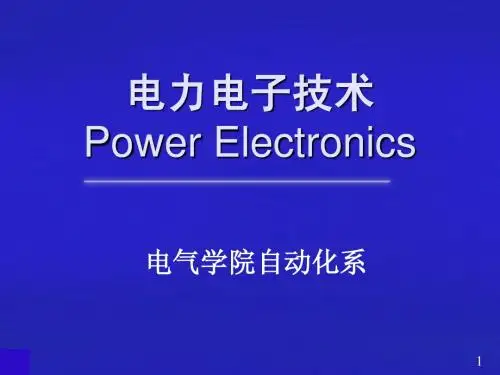
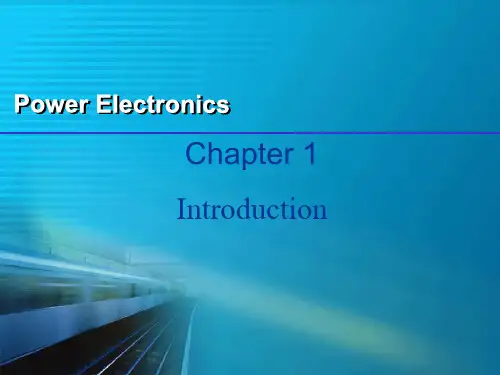
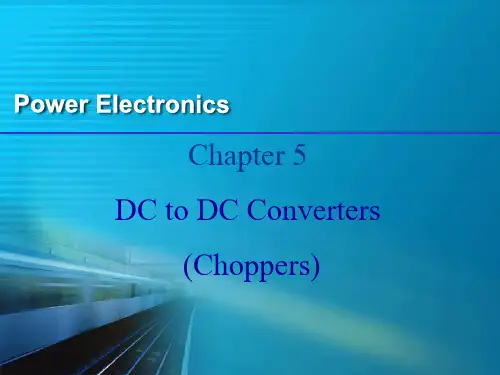
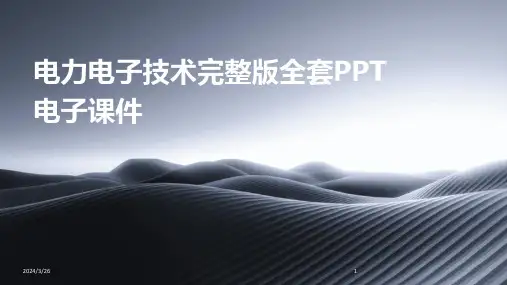
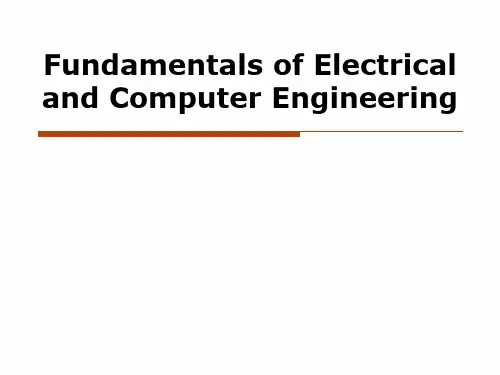
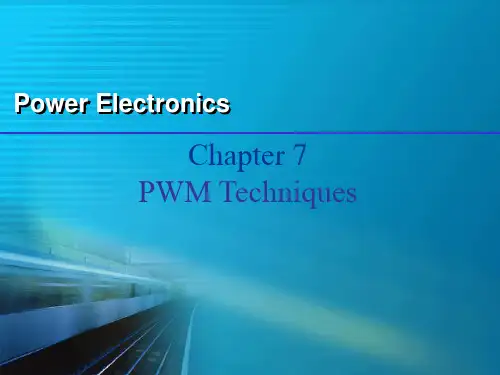
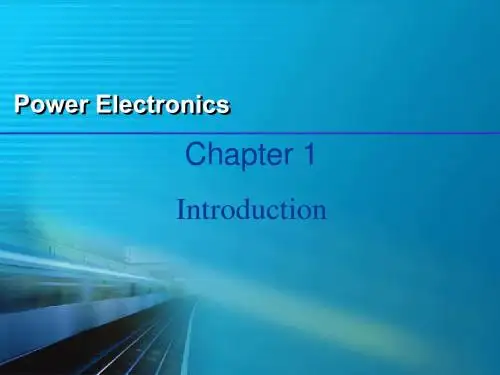
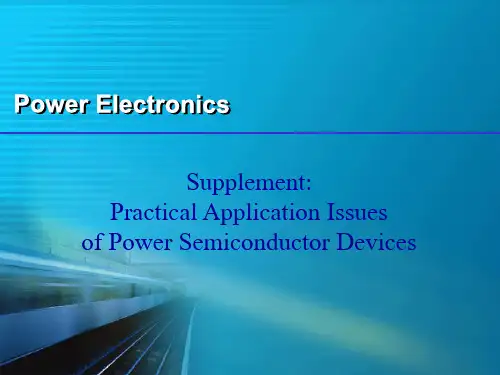
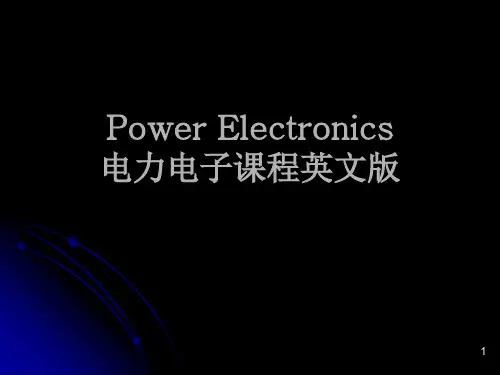
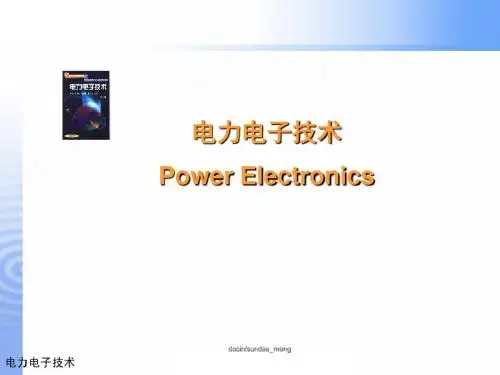
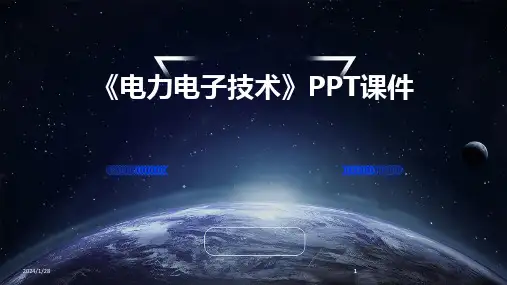
电力电子技术的定义与发展01020304定义晶闸管时代可控硅时代现代电力电子时代用于高压直流输电、无功补偿、有源滤波等,提高电力系统的稳定性和效率。
用于电动汽车、电动自行车、电梯等电机驱动系统,实现高效、节能的电机控制。
用于太阳能、风能等新能源发电系统,实现能源的高效利用和转换。
用于自动化生产线、机器人等工业设备,实现设备的精确控制和高效运行。
电力系统电机驱动新能源工业自动化数字化与智能化随着计算机技术和人工智能的发展,电力电子技术将实现数字化和智能化,提高系统的自适应能力和智能化水平。
高频化与高效化随着半导体材料和器件的发展,电力电子技术将实现更高频率和更高效率的电能转换。
绿色化与环保化随着环保意识的提高,电力电子技术将更加注重绿色、环保的设计理念,降低能耗和减少对环境的影响。
工作原理特点应用整流电路、续流电路等工作原理通过门极触发导通,无法自行关断特点耐压高、电流大、开关速度快应用直流电机调速、交流调压等工作原理特点应用工作原理特点应用逆变器、斩波器、电机驱动等工作原理特点应用工作原理开关速度快、耐压高、电流大、热稳定性好应用逆变器、斩波器、电机驱动等高端应用领域特点VS整流电路的作用整流电路的分类整流电路的工作原理整流电路的应用整流电路逆变电路逆变电路的作用逆变电路的分类逆变电路的工作原理逆变电路的应用直流-直流变流电路直流-直流变流电路的作用直流-直流变流电路的分类直流-直流变流电路的工作原理直流-直流变流电路的应用交流-交流变流电路交流-交流变流电路的作用交流-交流变流电路的工作原理A B C D交流-交流变流电路的分类交流-交流变流电路的应用电机驱动照明控制加热与焊接030201一般工业应用交通运输应用电动汽车驱动轨道交通牵引航空电源电力系统应用高压直流输电柔性交流输电通过电力电子技术可实现高压直流输电,减少输电损耗和占地面积。
智能电网风能发电通过电力电子技术可实现风能发电系统的变速恒频控制和并网运行。
1 Power Electronic ConceptsPower electronics is a rapidly developing technology. Components are tting higher current and voltage ratings, the power losses decrease and the devices become more reliable. The devices are also very easy tocontrol with a mega scale power amplification. The prices are still going down pr. kVA and power converters are becoming attractive as a mean to improve the performance of a wind turbine. This chapter will discuss the standard power converter topologies from the simplest converters for starting up the turbine to advanced power converter topologies, where the whole power is flowing through the converter. Further, different park solutions using power electronics arealso discussed.1.1 Criteria for concept evaluationThe most common topologies are selected and discussed in respect to advantages and drawbacks. Very advanced power converters, where many extra devices are necessary in order to get a proper operation, are omitted.1.2 Power convertersMany different power converters can be used in wind turbine applications. In the case of using an induction generator, the power converter has to convert from a fixed voltage and frequency to a variable voltage and frequency. This may be implemented in many different ways, as it will be seen in the next section. Other generator types can demand other complex protection. However, the most used topology so far is a soft-starter, which is used during start up in order to limit the in-rush current and thereby reduce the disturbances to the grid.1.2.1 Soft starterThe soft starter is a power converter, which has been introduced to fixedspeed wind turbines to reduce the transient current during connection or disconnection of the generator to the grid. When the generator speed exceeds the synchronous speed, the soft-starter is connected. Using firing angle control of the thyristors in the soft starter the generator is smoothly connected to the grid over a predefined number of grid periods. An example of connection diagram for the softstarter with a generator is presented in Figure1.Figure 1. Connection diagram of soft starter with generators.The commutating devices are two thyristors for each phase. These are connected in anti-parallel. The relationship between the firing angle (﹤) and the resulting amplification of the soft starter is non-linear and depends additionally on the power factor of the connected element. In the case of a resistive load, may vary between 0 (full on) and 90 (full off) degrees, in the case of a purely inductive load between 90 (full on) and 180 (full off) degrees. For any power factor between 0 and 90 degrees, w ill be somewhere between the limits sketched in Figure 2.Figure 2. Control characteristic for a fully controlled soft starter.When the generator is completely connected to the grid a contactor (Kbyp) bypass the soft-starter in order to reduce the losses during normal operation. The soft-starter is very cheap and it is a standard converter in many wind turbines.1.2.2 Capacitor bankFor the power factor compensation of the reactive power in the generator, AC capacitor banks are used, as shown in Figure 3. The generators are normally compensated into whole power range. The switching of capacitors is done as a function of the average value of measured reactive power during a certain period.Figure 3. Capacitor bank configuration for power factor compensation ina wind turbine.The capacitor banks are usually mounted in the bottom of the tower or in thenacelle. In order to reduce the current at connection/disconnection of capacitors a coil (L) can be connected in series. The capacitors may be heavy loaded and damaged in the case of over-voltages to the grid and thereby they may increase the maintenance cost.1.2.3 Diode rectifierThe diode rectifier is the most common used topology in power electronic applications. For a three-phase system it consists of six diodes. It is shown in Figure 4.Figure 4. Diode rectifier for three-phase ac/dc conversionThe diode rectifier can only be used in one quadrant, it is simple and it is notpossible to control it. It could be used in some applications with a dc-bus.1.2.4 The back-to-back PWM-VSIThe back-to-back PWM-VSI is a bi-directional power converter consisting of two conventional PWM-VSI. The topology is shown in Figure 5.To achieve full control of the grid current, the DC-link voltage must be boosted to a level higher than the amplitude of the grid line-line voltage. The power flow of the grid side converter is controlled in orderto keep the DC-link voltage constant, while the control of the generator side is set to suit the magnetization demand and the reference speed. The control of the back-to-back PWM-VSI in the wind turbine application is described in several papers (Bogalecka, 1993), (Knowles-Spittle et al., 1998), (Pena et al., 1996), (Yifan & Longya, 1992), (Yifan & Longya, 1995).Figure 5. The back-to-back PWM-VSI converter topology.1.2.4.1 Advantages related to the use of the back-to-back PWM-VSIThe PWM-VSI is the most frequently used three-phase frequency converter. As a consequence of this, the knowledge available in the field is extensive and well established. The literature and the available documentation exceed that for any of the other converters considered in this survey. Furthermore, many manufacturers produce components especially designed for use in this type of converter (e.g., a transistor-pack comprising six bridge coupled transistors and anti paralleled diodes). Due to this, the component costs can be low compared to converters requiring components designed for a niche production.A technical advantage of the PWM-VSI is the capacitor decoupling between the grid inverter and the generator inverter. Besides affording some protection, this decoupling offers separate control of the two inverters, allowing compensation of asymmetry both on the generator side and on the grid side, independently.The inclusion of a boost inductance in the DC-link circuit increases the component count, but a positive effect is that the boost inductance reduces the demands on the performance of the grid side harmonic filter, and offers some protection of the converter against abnormal conditions on the grid.1.2.4.2 Disadvantages of applying the back-to-back PWM-VSIThis section highlights some of the reported disadvantages of the back-to-back PWM-VSI which justify the search for a more suitable alternative converter:In several papers concerning adjustable speed drives, the presence of the DC link capacitor is mentioned as a drawback, since it is heavy and bulky, it increases the costs and maybe of most importance, - it reduces the overall lifetime of the system. (Wen-Song & Ying-Yu, 1998); (Kim & Sul, 1993); (Siyoung Kim et al., 1998).Another important drawback of the back-to-back PWM-VSI is the switching losses. Every commutation in both the grid inverter and the generator inverter between the upper and lower DC-link branch is associated with a hard switching and a natural commutation. Since the back-to-back PWM-VSI consists of two inverters, the switching losses might be even more pronounced. The high switching speed to the grid may also require extra EMI-filters.To prevent high stresses on the generator insulation and to avoid bearing current problems (Salo & Tuusa, 1999), the voltage gradient may have to be limited by applying an output filter.1.2.5 Tandem converterThe tandem converter is quite a new topology and a few papers only have treated it up till now ((Marques & Verdelho, 1998); (Trzynadlowski et al., 1998a); (Trzynadlowski et al., 1998b)). However, the idea behind the converter is similar to those presented in ((Zhang et al., 1998b)), where the PWM-VSI is used as an active harmonic filter to compensate harmonic distortion. The topology of the tandem converter is shown inFigure 6.Figure 6. The tandem converter topology used in an induction generator wind turbine system.The tandem converter consists of a current source converter, CSC, in thefollowing designated the primary converter, and a back-to-back PWM-VSI, designated the secondary converter. Since the tandem converter consists of four controllable inverters, several degrees of freedom exist which enable sinusoidal input and sinusoidal output currents. However, in this context it is believed that the most advantageous control of the inverters is to control the primary converter to operate in square-wave current mode. Here, the switches in the CSC are turned on and off only once per fundamental period of the input- and output current respectively. In square wave current mode, the switches in the primary converter may either be GTO.s, or a series connection of an IGBT and a diode.Unlike the primary converter, the secondary converter has to operateat a high switching frequency, but the switched current is only a small fraction of the total load current. Figure 7 illustrates the current waveform for the primary converter, the secondary converter, is, and the total load current il.In order to achieve full control of the current to/from the back-to-back PWMVSI, the DC-link voltage is boosted to a level above the grid voltage. As mentioned, the control of the tandem converter is treated in only a few papers. However, the independent control of the CSC and the back-to-back PWM-VSI are both well established, (Mutschler & Meinhardt, 1998); (Nikolic & Jeftenic, 1998); (Salo & Tuusa, 1997); (Salo & Tuusa, 1999).Figure 7. Current waveform for the primary converter, ip, the secondary converter, is, and the total load current il.1.2.5.1Advantages in the use of the Tandem ConverterThe investigation of new converter topologies is commonly justifiedby thesearch for higher converter efficiency. Advantages of the tandem converter are the low switching frequency of the primary converter, and the low level of the switched current in the secondary converter. It is stated that the switching losses of a tandem inverter may be reduced by 70%, (Trzynadlowski et al., 1998a) in comparison with those of an equivalent VSI, and even though the conduction losses are higher for the tandem converter, the overall converter efficiency may be increased.Compared to the CSI, the voltage across the terminals of the tandem converter contains no voltage spikes since the DC-link capacitor of the secondary converter is always connected between each pair of input- and output lines (Trzynadlowski et al., 1998b).Concerning the dynamic properties, (Trzynadlowski et al., 1998a) states that the overall performance of the tandem converter is superior to both the CSC and the VSI. This is because current magnitude commands are handled by the voltage source converter, while phase-shift current commands are handled by the current source converter (Zhang et al., 1998b).Besides the main function, which is to compensate the current distortion introduced by the primary converter, the secondary converter may also act like an active resistor, providing damping of the primary inverter in light load conditions (Zhang et al., 1998b).1.2.5.2 Disadvantages of using the Tandem ConverterAn inherent obstacle to applying the tandem converter is the high number of components and sensors required. This increases the costs and complexity of both hardware and software. The complexity is justified by the redundancy of the system (Trzynadlowski et al., 1998a), however the system is only truly redundant if a reduction in power capability and performance is acceptable.Since the voltage across the generator terminals is set by the secondary inverter, the voltage stresses at the converter are high.Therefore the demands on the output filter are comparable to those when applying the back-to-back PWM-VSI.In the system shown in Figure 38, a problem for the tandem converter in comparison with the back-to-back PWM-VSI is the reduced generator voltage. By applying the CSI as the primary converter, only 0.866% of the grid voltage can be utilized. This means that the generator currents (and also the current through the switches) for the tandem converter must be higher in order to achieve the same power.1.2.6 Matrix converterIdeally, the matrix converter should be an all silicon solution with no passive components in the power circuit. The ideal conventional matrix converter topology is shown in Figure 8.Figure 8. The conventional matrix converter topology.The basic idea of the matrix converter is that a desired input current (to/from the supply), a desired output voltage and a desired output frequency may be obtained by properly connecting the output terminals of the converter to the input terminals of the converter. In order to protect the converter, the following two control rules must be complied with: Two (or three) switches in an output leg are never allowed to be on at the same time. All of the three output phases must be connected to an input phase at any instant of time. The actual combination of the switchesdepends on the modulation strategy.1.2.6.1 Advantages of using the Matrix ConverterThis section summarises some of the advantages of using the matrix converter in the control of an induction wind turbine generator. For a low output frequency of the converter the thermal stresses of the semiconductors in a conventional inverter are higher than those in a matrix converter. This arises from the fact that the semiconductors in a matrix converter are equally stressed, at least during every period of the grid voltage, while the period for the conventional inverter equals the output frequency. This reduces thethermal design problems for the matrix converter.Although the matrix converter includes six additional power switches compared to the back-to-back PWM-VSI, the absence of the DC-link capacitor may increase the efficiency and the lifetime for the converter (Schuster, 1998). Depending on the realization of the bi-directional switches, the switching losses of the matrix inverter may be less than those of the PWM-VSI, because the half of the switchings become natural commutations (soft switchings) (Wheeler & Grant, 1993).1.2.6.2 Disadvantages and problems of the matrix converterA disadvantage of the matrix converter is the intrinsic limitation of the output voltage. Without entering the over-modulation range, the maximum output voltage of the matrix converter is 0.866 times the input voltage. To achieve the same output power as the back-to-back PWM-VSI, the output current of the matrix converter has to be 1.15 times higher, giving rise to higher conducting losses in the converter (Wheeler & Grant, 1993).In many of the papers concerning the matrix converter, the unavailability of a true bi-directional switch is mentioned as one of the major obstacles for the propagation of the matrix converter. In the literature, three proposals for realizing a bi-directional switch exists. The diode embedded switch (Neft & Schauder, 1988) which acts like a truebi-directional switch, the common emitter switch and the common collector switch (Beasant et al., 1989).Since real switches do not have infinitesimal switching times (which is not desirable either) the commutation between two input phases constitutes a contradiction between the two basic control rules of the matrix converter. In the literature at least six different commutation strategies are reported, (Beasant et al., 1990); (Burany, 1989); (Jung & Gyu, 1991); (Hey et al., 1995); (Kwon et al., 1998); (Neft & Schauder, 1988). The most simple of the commutation strategies are those reported in (Beasant et al., 1990) and (Neft & Schauder, 1988), but neither of these strategies complies with the basic control rules.译文1 电力电子技术的内容电力电子技术是一门正在快速发展的技术,电力电子元器件有很高的额定电流和额定电压,它的功率减小元件变得更加可靠、耐用.这种元件还可以用来控制比它功率大很多倍的元件。